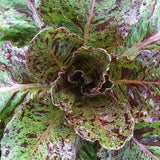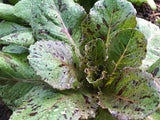Spotted Aleppo Lettuce
Lactuca sativa
This speckled heirloom romaine lettuce from Syria was introduced to England in the late 1600s, and to America by the late 1700s. It was offered by Philadelphia-based Bernard McMahon in the first known seed catalog in America in 1804 (his very first catalog came out 2 years earlier). This long-leafed variety is 8-10 inches tall and can be eaten young or mature.
Similar to Landis Winter Lettuce, we sow this variety in late fall and harvest in late winter and early spring. You can also plant in the early spring, and early fall for cool-season harvests.
Lettuce originates in the middle-east, and is often a central ingredient in Syria's famous Fattoush (bread salad), and sometimes in the Levantine Tabbouleh. Some say romaine lettuces are also called "cos" because lettuce is known as khus خس in Arabic. First cultivated as early as 2680 BC, lettuce was used by Egyptians to create oil from its seeds, and later was selected for its edible leaves, likely also by Egyptians.
Days to maturity: 40-60
Seeds per pack: 100
Germination rate: 84% on 09/29/2025
Planting / harvesting notes
Seed every 1" in rows 8-12" apart, 1/4-1/2" deep. Keep watered until germination. Thin to every 8". Harvest when you can't wait anymore!
Seed keeping notes
Lettuce is very much self-pollinating, but give at least 10 feet between plants (we give at least 35 feet) to avoid unwanted cross-pollination from flying insects. Allow the plants to bolt and flower. Often, flowering lettuce benefits from simple staking (we tie several plants together) so that the flowers and seedheads do not fall to the ground. Seed is ripe when the flowers turn to 'feathers', which are fluff balls like dandelions. In the moist summers of Pennsylvania, we harvest the entire seedheads when at least 50% of the plant has gone to seed. If there are dry days in the forcast, feel free to wait longer for more ripe seed. Cut the seedheads a few feet down, and allow to dry about a week in a sunny dry place like a greenhouse, sunny window, or even a car seat. Later, wearing a handkerchief or mask to avoid breathing in the feathers and dust, bang the seedheads in a bucket allowing the seed to fall to the bottom. The ripest seeds fall, the least ripe stay in the plant, so do not over do it. Sift through strainers to remove the large chaff, and then use your breath, a fan, or the wind to carefully blow off the smaller dust.







